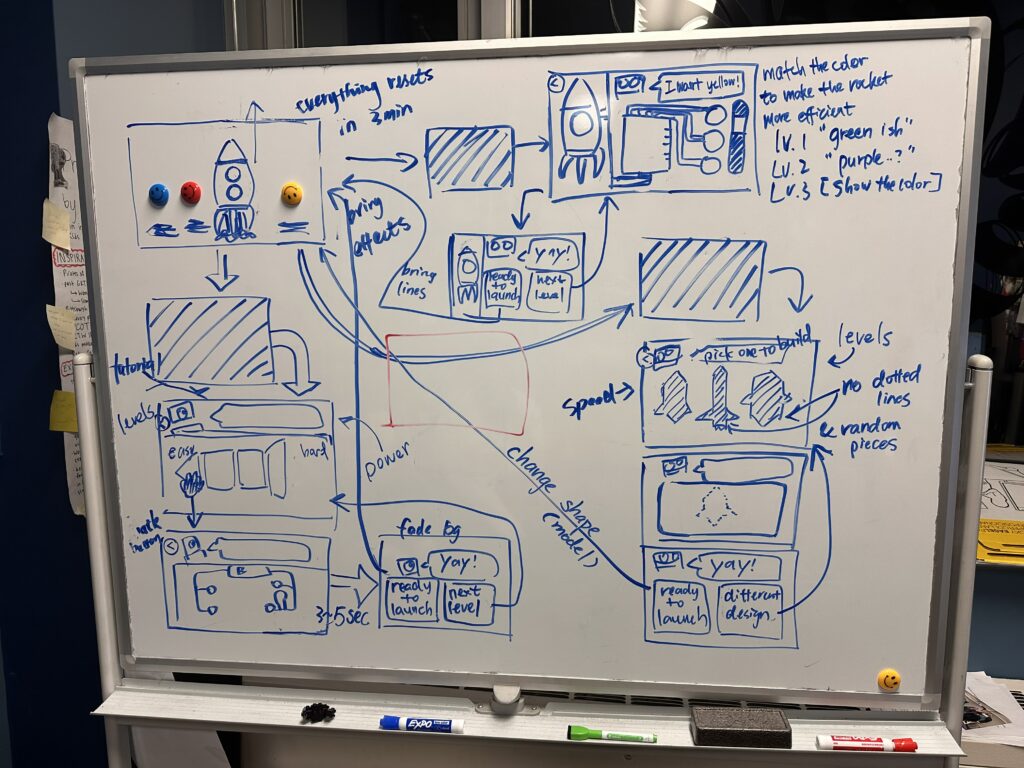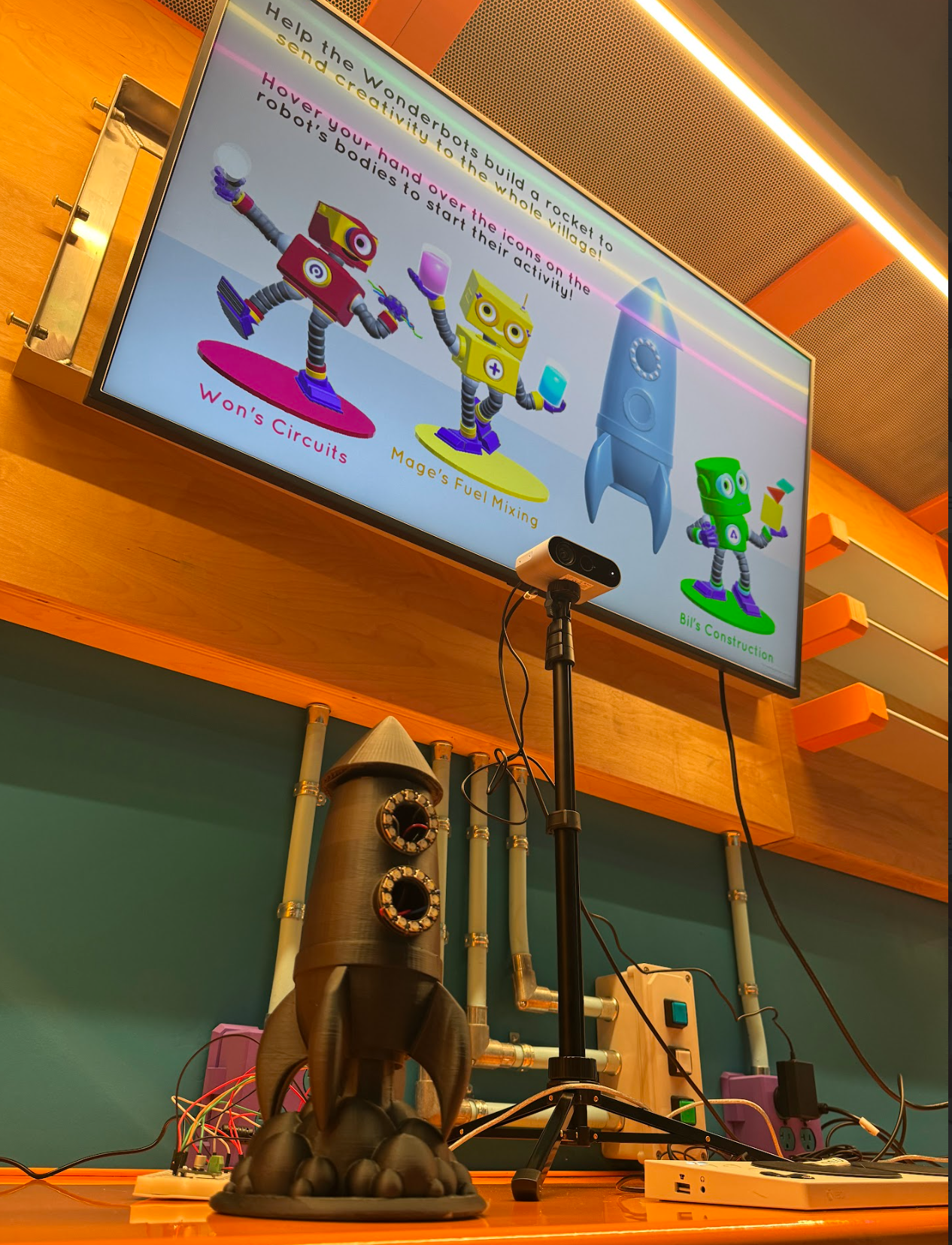Hardware Updates
We now have a working prototype of the physical rocket! We worked with Dave to wire the second neopixel LED ring and then integrated the arduino command code with the Unity project. We then met with Robert Zacharias to talk about the materials and designs we should go with for the final install. One of the biggest challenges will be permanently attaching the hardware. We don’t want to use something like epoxy, because in the event that this breaks, we would like the employees to be able to easily move to something else. The best way to do it would be to make the model in a way that allows us to mechanically attach the pieces. However, since our model is created in Maya, this is going to be more challenging to accomplish.
Playtesting
This week we had playtests in the ETC with faculty members as well as guests from a local middle school that were taking a tour. Each of these playtests provided valuable insight that we will be utilizing to improve and finalize the experience over the next 2 weeks.
Our first playtest was with Dave Culyba, whose main feedback was that the game lacked clarity. He didn’t understand how all the minigames connected together and didn’t feel that the payoff with the rocket was strong enough. He also had doubts about whether or not the game is suitable for our target audience – he felt that they felt like they appealed to a younger demographic.
We had a playtest with middle school students, and saw how they played was very different from how adults play. While adults tend to struggle with Bil’s game, wanting to move slowly to connect the pieces, kids like to move as a chaotically as possible. We also saw how they interacted with each other and tried to mess with their games as they played. One kid had prior interest in circuits, so he really enjoyed Won’s game and argued with his friends as they messed with his solutions to the puzzle. They made a good point that while they had the most fun playing Bil’s game together, they would probably enjoy Won’s game the most if they were alone.
Jesse’s main feedback was that he wanted us to really lean into the craziness and creativity in the game. He wants to be able to turn the rocket into wacky designs and colors and he wants the launch to be more dramatic. He liked the interactions, but felt there needed to be more room for kids to explore and make their own fun.
Redesign
Following our playtest with Dave, the team sat down for an in-depth design review session. We realize that the game flow is pretty unclear right now for naive guests. The rocket aspect feels like a random twist as it isn’t clearly shown anywhere else in the game.

Wonderlab!
Rushil and Melanie spent Friday night playtesting on site at the WonderLab. For this first night, a lot of time was spent on debugging. Despite the hand tracking being stable for all of our recent playtests using the same hardware setup, it was suddenly lagging again. There were also some unexpected issues in that the camera was picking up people walking in the puzzle portal, the room directly across from where BotMania will be running and they accidentally triggered the back button. There were some glitches with the rocket lights in Mage’s game as well as VFX in Won’s game. People also have a really hard time understanding that they need to hit pieces in Bil’s game. Changing the hand sprite to something like a sideways hand or a hand with a disk might help with that. There were a few kids who really enjoyed the game and came back multiple times to play. However there were a lot of small issues that prevented kids from being able to finish.
Malaya and I worked on some of the major issues that were found during the initial playtest and pushed a new build for the second night. After some research, we found that a common issue with the femto bolt is that it will occasionally establish a USB 2.0 connection, when a USB 3.0 connection is required for it to function properly. Simply replugging in the device will usually resolve the issue. Melanie and Rushil confirmed that the new build worked much better! After replugging in the camera, there was significantly less lag. There was a major difference between the two nights, after removing the back button and fixing a few of the more game-breaking bugs, kids were able to complete the experiences more easily. We were able to observe how the kids and their parents worked together to understand and solve the puzzles. One thing we saw is that parents would often try to guide their children by grabbing their hands and helping them to complete the puzzle. Unfortunately the sensor would get confused by the overlapping hands and make it hard for them to complete. Knowing that this is a way that families will try to play together, we will need to find a solution that makes it possible for them to interact this way.
Priorities For Next Week:
- Design
- We will begin working on the new design, with each game affecting the rocket in a different way.
- Programming
- Fixing bugs with the individual games
- Implementing the launch behavior
- Implement additional levels for all of the games
- Look into potential solutions to allow overlapping hands to be tracked separately – possibly using a different unity kinect package?
- Art
- Create finalized art assets

